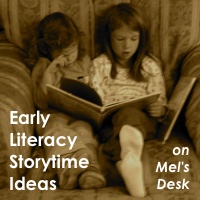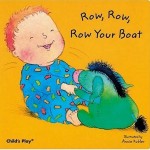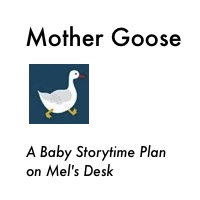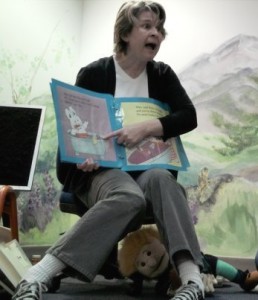Welcome to the middle of a short series of posts about what I think makes for a successful storytime! I’ve talked about loving storytime, embracing the performance, and knowing your material, but I don’t think any of those elements really make storytime come to life without engagement–engaging with our material, and engaging with our audience.
Engage with the Material
We can’t convince a group of kids to have fun shaking their sillies out unless WE are genuinely having fun shaking our sillies out, as well. Part of this has to do with not worrying about how we look or what people will think while we’re on stage, but part of it also has to do with choosing materials for storytime that we enjoy ourself.
Craft your storytime (within age-appropriate parameters) to reflect the books and songs and flannelboards and other elements that you enjoy most, and you will find yourself looking forward to sharing them with the kids and their parents, and they will look forward to each week’s storytime to find out what you’ll be sharing with them next.
This means paying critical attention to what features you like in picture books, so you can make efficient decisions when new books show up at your library. For me, this meant recognizing my impatience with sappy sweet Mommy-loves-you books and allowing myself not to read them in storytime. Kids will enjoy hearing them so much more from their own mommies than from pragmatic & unsentimental me!
It means noticing when you are getting bored with a type of book or rhyme or fingerplay, and seeing out alternatives. I realized a few years ago that I was running out of steam for the “5 Little Whatsit” rhymes. I wasn’t really presenting them with any enthusiasm, and I felt my storytimes became stronger when I stopped relying on them so heavily just because they were readily available.
If you’ve been singing the same opening and closing songs for a couple of years for the sake of continuity, that’s great–we know how much impact repetition has on children’s learning–but do give yourself permission to switch out from time to time. I’ve been doing the same openings and closings for at least four years now…some moms and dads have come back with baby number two and I’m still plugging away with them! Each time we take a break at the end of summer I think about introducing a new song or two, but so far it’s felt okay to keep going. When the time is right I know I can switch, and that helps me stay engaged with the ones I have and not feel forced into a routine.
Highlighting the materials you enjoy may mean being creative with your theme planning, or doing away with a theme-based storytime altogether! For those of us who present with themes, this can seem like sacrilege, but in fact thousands of storytime providers every week skip the theme entirely (or back into a theme instead of start with one) and the world marches on! (I know, it’s shocking.) I like themes, but I don’t like it when I find myself considering a lame rhyme or a second-rate picture book just because it “fits.” I promise, no one is scoring your game, and there are creative ways to introduce just about any topic, so choose what you like best.
Of course, now I feel I have to include the caveat that we should all experiment from time to time with new books, songs, games, and all that. We want to present what we love, but we also need to stay open to the possibility that we might fall in love with something completely unexpected. Last fall I read “I Want My Hat Back” to a group of adults, and one of them came up to me afterwards and said, “I didn’t really like that book until I heard you read it.” Listen in on your colleagues’ storytimes, ask around for fresh ideas, and try something new every once in awhile. Then tell us about it so we can try it too!
Engage with the Audience
So we want to have a storytime stuffed full of great materials, but storytime isn’t storytime until it’s presented to an audience. Another aspect of storytime engagement is seeking out a connection with our groups as we present. It’s the personal connection that our families feel with us that brings them back, as much as the storytime or library experience.
Look for ways, as far as possible, to build genuine relationships with your storytime children. Work on learning their names, by using nametags, preregistration, or introductions in storytime to help you out. Arrive and set up for storytime as early as your schedule allows, so you are there as families come in and can chat with them before storytime begins. Chat as you break down your storytime set up if you don’t have time to stay and play afterwards.
Make eye contact with individuals in your audience while you are performing. You will feel connected to them, and you’ll also be aware of where their attention is focused and when it wanders a bit. This can help you assess which materials are the most effective and most fun for your listeners. If your group size is manageable, ask open-ended questions as you read the books to foster participation and help you learn the children’s personalities.
In addition to scripted action rhymes and fingerplays, consider handing out props such as scarves, shaker eggs, pipecleaners, finger puppets, or other small items and leading the children in some open-ended movement activities. This gives you a chance to make comments directly to the kids in the middle of storytime: “Oooh, Connor is twirling his scarf above his head! Let’s all try that!” Or, “I see Louisa lifting her knees up so high while she marches! Can you march too?” The kids will love that you are paying close attention, and so will their grown-ups.
I realize these tips are skewed to my experience of small-to-medium size storytimes of no more than 50 people in the room, child and grownups (and often less). If your groups are larger, what tips do you have for us that help you make connections and engage with your audience?
What thoughts do you have about engaging with your materials and how doing so effects storytime? Let us know that too! And come back next week for my last “Essential Elements” post!









.jpg)
